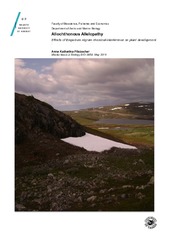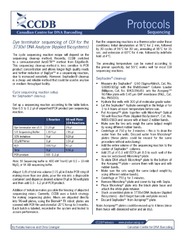Institutt for arktisk og marin biologi: Recent submissions
Now showing items 1081-1100 of 2084
-
A novel use of the leukocyte coping capacity assay to assess the immunomodulatory effects of organohalogenated contaminants in avian wildlife
(Journal article; Tidsskriftartikkel; Peer reviewed, 2020-06-19)Apex predators are characterized by high levels of biomagnifying organohalogenated contaminants (OHCs) which have been found to induce detrimental health effects in wildlife, such as immune system impairment. The leukocyte coping capacity (LCC) assay is a functional real-time measure of an innate immune response essential in pathogen resistance, known as the respiratory burst. The current study ... -
Impacts of salmon lice on mortality, marine migration distance and premature return in sea trout
(Journal article; Tidsskriftartikkel; Peer reviewed, 2020-02-06)Brown trout <i>Salmo trutta</i> (L.) is a facultative anadromous species, where a portion of individuals in populations with access to the sea perform migrations to use the richer feeding resources. We investigated the effect of salmon lice <i>Lepeophtheirus salmonis</i> (Krøyer 1837) infestation on the survival and behaviour of wild trout post-smolts (average fork length = 180 mm) during their ... -
Temporal trends of persistent organic pollutants in Barents Sea polar bears (Ursus maritimus) in relation to changes in feeding habits and body condition
(Journal article; Tidsskriftartikkel; Peer reviewed, 2018-12-14)Temporal trends of persistent organic pollutants (POPs: PCBs, OH-PCBs, <i>p,p′</i>-DDE, HCB, β-HCH, oxychlordane, BDE-47, and 153) in relation to changes in feeding habits and body condition in adult female polar bears (<i>Ursus maritimus</i>) from the Barents Sea subpopulation were examined over 20 years (1997–2017). All 306 samples were collected in the spring (April). Both stable isotope values ... -
What feeds the benthos in the Arctic basins? Assembling a carbon budget for the deep Arctic ocean
(Journal article; Tidsskriftartikkel; Peer reviewed, 2020-04-16)Half of the Arctic Ocean is deep sea (>1000 m), and this area is currently transitioning from being permanently ice-covered to being seasonally ice-free. Despite these drastic changes, it remains unclear how organisms are distributed in the deep Arctic basins, and particularly what feeds them. Here, we summarize data on auto- and heterotrophic organisms in the benthic, pelagic, and sympagic realm ... -
A novel use of the leukocyte coping capacity assay to assess the immunomodulatory effects of organohalogenated contaminants in avian wildlife
(Journal article; Tidsskriftartikkel; Peer reviewed, 2020-05)Apex predators are characterized by high levels of biomagnifying organohalogenated contaminants (OHCs) which have been found to induce detrimental health effects in wildlife, such as immune system impairment. The leukocyte coping capacity (LCC) assay is a functional real-time measure of an innate immune response essential in pathogen resistance, known as the respiratory burst. The current study ... -
Cold Seeps in a Warming Arctic: Insights for Benthic Ecology
(Journal article; Tidsskriftartikkel; Peer reviewed, 2020-05-21)Cold-seep benthic communities in the Arctic exist at the nexus of two extreme environments; one reflecting the harsh physical extremes of the Arctic environment and another reflecting the chemical extremes and strong environmental gradients associated with seafloor seepage of methane and toxic sulfide-enriched sediments. Recent ecological investigations of cold seeps at numerous locations on the ... -
Higher spatial than seasonal variation in floodplain soil eukaryotic microbial communities
(Journal article; Tidsskriftartikkel; Peer reviewed, 2020-05-10)Beta diversity is a key component of biodiversity with implications ranging from species dynamics to ecosystem functioning. However, β-diversity and its drivers have received little attention, especially for micro-eukaryotes which play key roles in soil functioning. We studied the diversity of soil micro-eukaryotes in a Swiss lowland floodplain using high-throughput Illumina sequencing of soil DNA. ... -
Tiny but fatty: Lipids and fatty acids in the daubed shanny (Leptoclinus maculatus), a small fish in Svalbard waters
(Journal article; Tidsskriftartikkel; Peer reviewed, 2020-02-28)The seasonal dynamic of lipids and their fatty acid constituents in the lipid sac and muscles of pelagic postlarval <i>Leptoclinus maculatus</i>, an ecologically important fish species in the Arctic food nets, in Kongsfjord, Svalbard waters was studied. The determination of the qualitative and quantitative content of the total lipids (TLs), total phospholipids (PLs), triacylglycerols (TAGs), cholesterol ... -
RNA profiling identifies novel, photoperiodhistory dependent markers associated with enhanced saltwater performance in juvenile Atlantic salmon
(Journal article; Tidsskriftartikkel; Peer reviewed, 2020-04-08)Atlantic salmon migrate to sea following completion of a developmental process known as smolting, which establishes a seawater (SW) tolerant phenotype. Smolting is stimulated by exposure to long photoperiod or continuous light (LL) following a period of exposure to short photoperiod (SP), and this leads to major changes in gill ion exchange and osmoregulatory function. Here, we performed an RNAseq ... -
Storm-driven across-shelf oceanic flows into coastal waters
(Journal article; Tidsskriftartikkel; Peer reviewed, 2020-04-02)The North Atlantic Ocean and northwest European shelf experience intense low-pressure systems during the winter months. The effect of strong winds on shelf circulation and water properties is poorly understood as observations during these episodes are rare, and key flow pathways have been poorly resolved by models up to now. We compare the behaviour of a cross-shelf current in a quiescent period in ... -
Soil chemistry changes beneath decomposing cadavers over a one-year period
(Journal article; Tidsskriftartikkel, 2018-03-06)Decomposing vertebrate cadavers release large, localized inputs of nutrients. These temporally limited resource patches affect nutrient cycling and soil organisms. The impact of decomposing cadavers on soil chemistry is relevant to soil biology, as a natural disturbance, and forensic science, to estimate the postmortem interval. However, cadaver impacts on soils are rarely studied, making it difficult ... -
Comparison of budburst phenology trends and precision among participants in a citizen science program
(Journal article; Tidsskriftartikkel; Peer reviewed, 2018-11-01)Quantifying shifts in plant phenology in response to climate change represents an ongoing challenge, particularly in mountain ecosystems. Because climate change and phenological responses vary in space and time, we need long-term observations collected at a broad spatial scale. While data collection by volunteers is a promising approach to achieve this goal, one major concern with citizen science ... -
Alien species in Norway: results from quantitative ecological impact assessments
(Journal article; Tidsskriftartikkel; Peer reviewed, 2020-05-20)1. Due to globalisation, trade and transport, the spread of alien species is increasing dramatically. Some alien species become ecologically harmful by threatening native biota. This can lead to irreversible changes in local biodiversity and ecosystem functioning, and, ultimately, to biotic homogenisation.<p><p> 2. We risk-assessed all alien plants, animals, fungi and algae, within certain ... -
Sampling planktonic salmon lice in Norwegian fjords
(Journal article; Tidsskriftartikkel; Peer reviewed, 2019-12-19)Risk of mortality of wild salmon caused by salmon lice is used as an index for managing aquaculture production in Norway and is based on monitoring of lice attached to wild salmonids and modelled concentrations of lice larvae in fjords. Direct sampling of lice from Norwegian waters to determine concentrations has never been published scientifically and has been considered non-feasible for monitoring ... -
Allochthonous Allelopathy. Effects of Empetrum nigrum chemical interference on plant development
(Master thesis; Mastergradsoppgave, 2016-05-20)The dwafshrub Empetrum nigrum uses phenolic compounds exuded by its leaves to depress the germination and growth of its surroundings. The allelopathic effect has, only been studied in areas immediately surrounding the plant (autochthonous allelopathy) but not in an open system apptoach that takes into account that a multitude of EMpetrum nigrum leaves get introduced into new environments through ... -
Species validity of five common northern/Arctic spring bloom diatoms: a combined morphological and molecular study
(Master thesis; Mastergradsoppgave, 2020-02-15)Relevant taxonomical morphological characters of five common spring bloom centric diatoms, preliminary identified as Attheya longicornis Crawford & Gardner, Chaetoceros furcellatus Yendo, Porosira glacialis Jørgensen, Coscinodiscus sp. and Skeletonema marinoi Sarno & Zingone were observed and described using light and scanning electron microscope. Further, samples of cultured diatoms were sent to ... -
End-user involvement to improve predictions and management of populations with complex dynamics and multiple drivers
(Journal article; Tidsskriftartikkel; Peer reviewed, 2020-03-11)Sustainable management of wildlife populations can be aided by building models that both identify current drivers of natural dynamics and provide near-term predictions of future states. We employed a Strategic Foresight Protocol (SFP) involving stakeholders to decide the purpose and structure of a dynamic state-space model for the population dynamics of the Willow Ptarmigan, a popular game species ... -
Investigating population genomic structure of salmon lice (Lepeophtheirus salmonis) in northern Norway
(Master thesis; Mastergradsoppgave, 2019-05-14)Salmon louse (Lepeophtheirus salmonis) is a parasitic copepod that causes significant damage to Atlantic salmon (Salmo salar) and incurs significant costs to the salmonid aquaculture industry. In Norway, the industry has been coping with salmon lice issues with various methods such as chemical treatments, but it has resulted in an acquisition of resistance in salmon lice towards the existing delousing ... -
Salmon louse (Lepeophtheirus salmonis (Krøyer)) control methods and efficacy in atlantic salmon (Salmo salar (Linnaeus)) aquaculture: A literature review
(Journal article; Tidsskriftartikkel; Peer reviewed, 2020-03-31)The salmon louse (<i>Lepeophtheirus salmonis</i>) causes problems in Atlantic salmon (<i>Salmo salar</i>) aquaculture in the Northern Hemisphere, because infestations can result in both a loss of production and in fish mortality. Several types of treatment have been used to control louse infestations, but these have seen varying success. The aim of this review is to examine the efficacy and safety ... -
Migration and habitat use of the landlocked riverine Atlantic salmon Salmo salar småblank
(Journal article; Tidsskriftartikkel; Peer reviewed, 2020-04-18)“Småblank” is the only population of Atlantic salmon in Europe living its entire life in the river habitat without performing migrations to the sea or lakes. Home range size and habitat use were compared between an unregulated tributary and hydro-power regulated parts of the main river during 2014–2017. In total, 140 småblank were tagged with radio transmitters and tracked for 4–5 months. Tagged ...


 English
English norsk
norsk


















